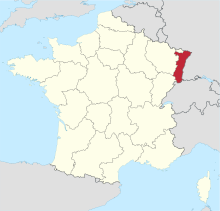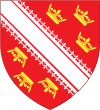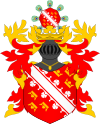Alsace independence movement
Mouvement autonomiste alsacien | |
Alsace d'abord Unser Land |
| Part of a series on |
| Alsace |
|---|
|
|

The Alsace independence movement (
.Purposes generally include opposition to centralist territorial, political and legal pretensions of either
Several mass
The movement of greater autonomy of Alsace runs partly parallel to that of Alemannic separatism, originating in the Napoleonic era (c. 1805–1815) and briefly revived both after World War I (1919) and after World War II (1946–1952).
History

Background
Due to expansionist doctrines of
Over the centuries, many figures and organisations have contributed to the cause of rejected either or both of these pretentions, promoting varying degrees of autonomy or even independence, both in public and in form of political participation.
Various autonomist and separatist movements in Alsace have received support from over the political spectrum, including left, centre and right, comprising diverse political ideologies.
19th century
World War II
The establishment of
- fr:Fritz Spieser (1902-1987)
- de:Paul Schall (1898-1981)
- fr:Joseph Bilger (1905-1975)
- fr:Marcel Stürmel (1900-1972)
- fr:Camille Dahlet (1883-1963)
- fr:Joseph Rossé (1892–1951)
- Jean-Pierre Mourer (1897-1947)
- Charles Hueber (1883-1943)
- fr:Charles Roos (1878-1940)
- Eugène Ricklin (1862–1935)
After war, also related groups fr:Nanziger and fr:Loups Noirs remain notable.
However, other Alsatian were staunch opponents of the Nazi occupation, such as the artist Jean-Jacques Waltz.
After reattachment to France



In contemporary Alsace,
Political parties
- Alsace d'abord
- fr:Robert Spieler (born 1951) (as well as other political parties)
- fr:Jacques Cordonnier (born 1950)
- fr:Front culturel alsacien
- fr:André Weckmann (1924-2012)
- fr:Andrée Buchmann (born 1956)
Organisations
Other
- fr:Pierre Zind (1923-1988)
Loss of regional status
Despite many protests, the new French region of Grand Est was introduced with ratification on 1 January 2016.
Gallery
-
Painting of the ceremony of the Schwoertag (circa 1785), Musée historique de Strasbourg.
-
Statue of GeneralJean Baptiste Kléber (1753–1800) in Place Kléber, Strasbourg, erected in 1838. Kléber, who was born to a builder in Strasbourg, was undoubtedly one of the greatest generals of the French Revolutionary Wars; second in command only to Napoleon before death in Cairo, Egypt.
-
The flag of Alsace in illustration by Charles Spindler.
-
Bilingual postcard.
-
The replica of the Statue of Liberty in Colmar, the birth town of its sculptor Frédéric Auguste Bartholdi, has been a notable site of assembly of protests against the new French region Grand Est.
-
Alsace has been the subject of many conflicts. Here, a painting from 1887 depicting a child being taught about the "lost" province ofAlsace-Lorraine in the aftermath of the Franco-Prussian Warthat is depicted in the colour black on a map of France.
-
Alsatian postal card during World War I (1914-1918): "Wir kennen keine Parteien mehr" (German: "We don't know any parties anymore").
-
Ausruf der Republik - theNovember 1918 in Alsace-Lorraine.
-
Military Council in Strasbourg, 15 November 1918.
-
André Malraux (winter 1944-45) as Commander of the Alsace-Lorraine Independent Brigade (France), a unit that fought alongside regular French Army forces in World War II.
-
Monument in .
-
Protesters holding a banner saying "No to merger" (Non a la fusion) during a demonstration in November 2014 in Strasbourg, against the merger of Grand Est.
See also
History
- es:Alsacia en 1789
- November 1918 in Alsace-Lorraine
- Alemannic separatism
- Grand Est#Opposition
Politics
- Alsace d'abord (fr:Espace nouveau jeune, fr:Jeune Alsace)
- Unser Land
- fr:Union du peuple alsacien
- fr:Fer's Elsass
- de:Nationalforum Elsass-Lothringen
- fr:Front culturel alsacien
- Independents of Popular Action)
Footnotes
This article includes a improve this article by introducing more precise citations. (April 2018) ) |
References
- Heiko Haumann: „Schwäbisch-alemannische Demokratie“ gegen „Staufisch-schwäbischen Imperialismus“? Politische Konzeptionen in Baden und Württemberg 1945–1952. In Allmende. Zeitschrift für Literatur. Bd. 8, Nr. 20, Karlsruhe 1988, 36–52, ISSN 0720-3098.
- Manfred Joss: Schwäbisch-Alemannische Demokratie. Vision und Scheitern eines Separatstaats im deutschen Südwesten nach dem Zweiten Weltkrieg. Lizentiatsarbeit, Historisches Institut, Universität Bern 2005.
- Jürgen Klöckler: „Das Land der Alemannen …“. Pläne für einen Heimatstaat im Bodenseeraum nach 1945. UVK Verlagsgesellschaft, Konstanz 1999, ISBN 3-89669-906-7.














